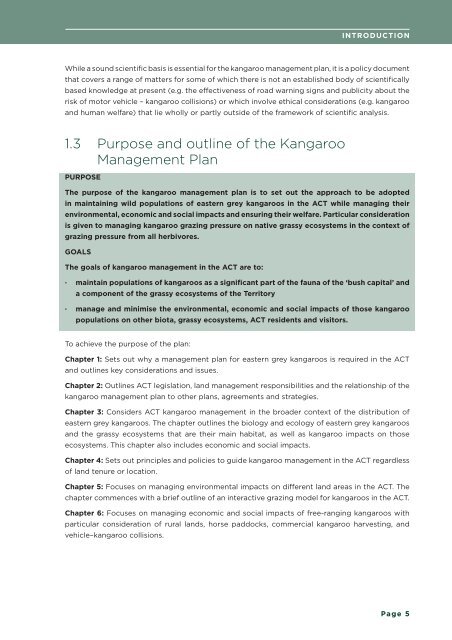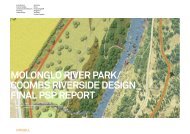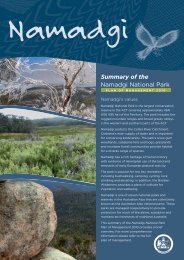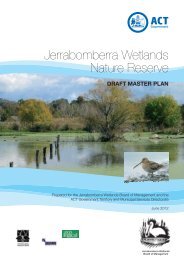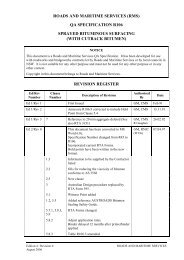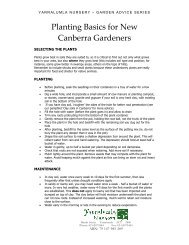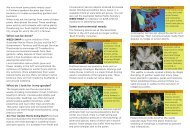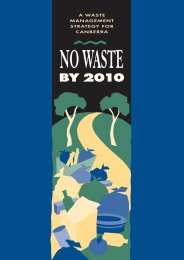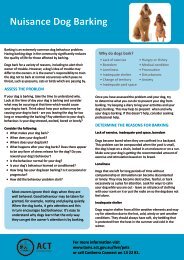Kangaroo Managment Plan - Territory and Municipal Services - ACT ...
Kangaroo Managment Plan - Territory and Municipal Services - ACT ...
Kangaroo Managment Plan - Territory and Municipal Services - ACT ...
You also want an ePaper? Increase the reach of your titles
YUMPU automatically turns print PDFs into web optimized ePapers that Google loves.
INTRODUCTION<br />
While a sound scientific basis is essential for the kangaroo management plan, it is a policy document<br />
that covers a range of matters for some of which there is not an established body of scientifically<br />
based knowledge at present (e.g. the effectiveness of road warning signs <strong>and</strong> publicity about the<br />
risk of motor vehicle – kangaroo collisions) or which involve ethical considerations (e.g. kangaroo<br />
<strong>and</strong> human welfare) that lie wholly or partly outside of the framework of scientific analysis.<br />
1.3 Purpose <strong>and</strong> outline of the <strong>Kangaroo</strong><br />
Management <strong>Plan</strong><br />
PURPOSE<br />
The purpose of the kangaroo management plan is to set out the approach to be adopted<br />
in maintaining wild populations of eastern grey kangaroos in the <strong>ACT</strong> while managing their<br />
environmental, economic <strong>and</strong> social impacts <strong>and</strong> ensuring their welfare. Particular consideration<br />
is given to managing kangaroo grazing pressure on native grassy ecosystems in the context of<br />
grazing pressure from all herbivores.<br />
GOALS<br />
The goals of kangaroo management in the <strong>ACT</strong> are to:<br />
· maintain populations of kangaroos as a significant part of the fauna of the ‘bush capital’ <strong>and</strong><br />
a component of the grassy ecosystems of the <strong>Territory</strong><br />
· manage <strong>and</strong> minimise the environmental, economic <strong>and</strong> social impacts of those kangaroo<br />
populations on other biota, grassy ecosystems, <strong>ACT</strong> residents <strong>and</strong> visitors.<br />
To achieve the purpose of the plan:<br />
Chapter 1: Sets out why a management plan for eastern grey kangaroos is required in the <strong>ACT</strong><br />
<strong>and</strong> outlines key considerations <strong>and</strong> issues.<br />
Chapter 2: Outlines <strong>ACT</strong> legislation, l<strong>and</strong> management responsibilities <strong>and</strong> the relationship of the<br />
kangaroo management plan to other plans, agreements <strong>and</strong> strategies.<br />
Chapter 3: Considers <strong>ACT</strong> kangaroo management in the broader context of the distribution of<br />
eastern grey kangaroos. The chapter outlines the biology <strong>and</strong> ecology of eastern grey kangaroos<br />
<strong>and</strong> the grassy ecosystems that are their main habitat, as well as kangaroo impacts on those<br />
ecosystems. This chapter also includes economic <strong>and</strong> social impacts.<br />
Chapter 4: Sets out principles <strong>and</strong> policies to guide kangaroo management in the <strong>ACT</strong> regardless<br />
of l<strong>and</strong> tenure or location.<br />
Chapter 5: Focuses on managing environmental impacts on different l<strong>and</strong> areas in the <strong>ACT</strong>. The<br />
chapter commences with a brief outline of an interactive grazing model for kangaroos in the <strong>ACT</strong>.<br />
Chapter 6: Focuses on managing economic <strong>and</strong> social impacts of free-ranging kangaroos with<br />
particular consideration of rural l<strong>and</strong>s, horse paddocks, commercial kangaroo harvesting, <strong>and</strong><br />
vehicle–kangaroo collisions.<br />
Page 5


